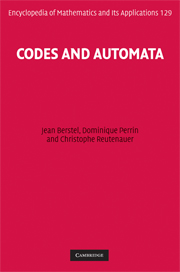Book contents
- Frontmatter
- Contents
- Preface
- 1 Preliminaries
- 2 Codes
- 3 Prefix codes
- 4 Automata
- 5 Deciphering delay
- 6 Bifix codes
- 7 Circular codes
- 8 Factorizations of free monoids
- 9 Unambiguous monoids of relations
- 10 Synchronization
- 11 Groups of codes
- 12 Factorizations of cyclic groups
- 13 Densities
- 14 Polynomials of finite codes
- Solutions of exercises
- Appendix: Research problems
- References
- Index of notation
- Index
12 - Factorizations of cyclic groups
Published online by Cambridge University Press: 05 March 2013
- Frontmatter
- Contents
- Preface
- 1 Preliminaries
- 2 Codes
- 3 Prefix codes
- 4 Automata
- 5 Deciphering delay
- 6 Bifix codes
- 7 Circular codes
- 8 Factorizations of free monoids
- 9 Unambiguous monoids of relations
- 10 Synchronization
- 11 Groups of codes
- 12 Factorizations of cyclic groups
- 13 Densities
- 14 Polynomials of finite codes
- Solutions of exercises
- Appendix: Research problems
- References
- Index of notation
- Index
Summary
In this chapter we describe the links between codes and factorizations of cyclic groups. It happens that for any finite maximal code X one can associate with each letter a several factorizations of the cyclic group Z/nZ where n is the integer such that an is in the code X. These factorizations play a role in several places in the theory of codes. They have appeared several times previously in this book. This chapter gives a systematic presentation.
We begin with an introduction to the notion of factorizations of cyclic groups (Section 12.1).We then study how factorizations arise in connection with two special kinds of words: bayonets (Section 12.2) and hooks (Section 12.3). We will see that factorizations of cyclic groups give insight into several properties of codes, like being synchronized or being finitely completable.
Factorizations of cyclic groups
Let G be a group written additively. Given two subsets L, R of G, we write L + R = ﹛l + r | l Є L, r Є R﹜. The sum L + R is direct if for any element g inG, there exists at most one pair (l, r) with l Є L and r Є R such that g = l + r. This means that for finite sets L, R, the sum is direct if and only if Card(L + R) = Card(L) Card(R). The pair (L, R) is called a factorization if G = L + R and the sum is direct. We also say that G = L + R is a factorization of G.
Information
- Type
- Chapter
- Information
- Codes and Automata , pp. 435 - 450Publisher: Cambridge University PressPrint publication year: 2009
